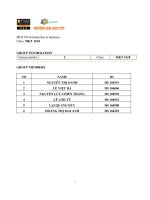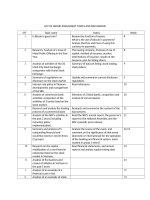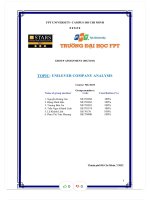group assignment spring 2022 mgt103 bitis
Bạn đang xem bản rút gọn của tài liệu. Xem và tải ngay bản đầy đủ của tài liệu tại đây (2.01 MB, 31 trang )
<span class="text_page_counter">Trang 1</span><div class="page_container" data-page="1">
<b><small> GROUP ASSIGNMENT </small></b>
<b> SPRING 2022 - MGT103 </b>
<b> </b>
<b> Lecturer :</b>
<b> Nguyễn Thị Mai Anh </b><b> Class : HM1604 Course : MGT103 Team 5 </b>
<b> Đỗ Quốc Khánh - HS160438</b>
<b><small> </small></b>
<b> Vũ Cao Sơn - HS160067 </b>
</div><span class="text_page_counter">Trang 2</span><div class="page_container" data-page="2"><b><small> </small> TABLE OF CONTENTI - Introduction company ( Vũ Cao Sơn ) </b>
1 - History begin<b> </b>
2 - Business areas
3 - Overview of business activities
<b>II - Literature review & Critical analysis</b>
1 - Organization structure (Lê Công Chiến)2 - Business strategy (Đỗ Quốc Khánh)
3 - Human resource management ( Nguyễn Tiến Trường ) 4 - Challenges ( Vũ Thị Loan )
Challenges in the company's current period
<b>III - Recommendation and conclusion ( Vũ Thị Loan ) </b>
1 - Advantage 2 - Disadvantage
3 - Proposal to improve the company
<b> </b>
</div><span class="text_page_counter">Trang 3</span><div class="page_container" data-page="3"><b> </b>
<b>MGT103 – Introduction to Management</b>
<b>I - Introduction company </b>
With today's growing market economy, grasping trends and promoting strengths is essential for the development of businesses. Especially the fashion industry, footwear has become a key industry and very important in life. However, with the development of mass media and increasing customer demand, quality is not enough, any product chosen by consumers needs to be a combination of many different types of products. element . And the task of a business is to have appropriate solutions to meet the needs of consumers.
And when it comes to footwear brands in Vietnam, we can't help but mention Bitis,a brand that has existed and developed for nearly 30 years. There has been a lot of dedication and brought customers a lot of quality products. To learn about the organizational structure , business strategy , challenges that Bitis faces and offer solutions for Bitis company to complete . Our team made this essay .
<b>1 - History begin </b>
1982: Started from two production complexes Binh Tien and Van Thanh at Binh Tien Street, District 6, Ho Chi Minh City with 20 workers, specializingin the production of simple rubber sandals.
In 1986: 2 cooperative groups merged to form Binh Tien Rubber
Cooperative operating in District 6, specializing in the production of sandals and slippers, for domestic consumption and export to Eastern and Western European countries.
1989: Binh Tien Rubber Cooperative became the first non-state entity in Vietnam that was granted the right to directly import and export by the State.
1990: Binh Tien Rubber Cooperative invested completely in Taiwanese technology and produced new products (EVA foam footwear) to increase competitiveness with imported goods.
1991: Established Son Quan Joint Venture Company - a joint venture between Binh Tien Rubber Cooperative and Taiwan SunKuan Company - specializing in the production of comedy and slippers for export. This is the first joint venture between a Vietnamese private economic unit and a foreigncompany (term of 18 years).
1992: Binh Tien Rubber Cooperative transformed into Binh Tien Consumer Goods Manufacturing Company (Biti's); specializes in manufacturing all kinds of foam sandals, sports sandals, men's and women's leather shoes,
</div><span class="text_page_counter">Trang 4</span><div class="page_container" data-page="4">sports shoes, western shoes, comedy,... for domestic and foreign consumption.
1995: Established Binh Tien Dong Nai Co., Ltd (Dona Biti's)Year 2000: Established a representative office in Yunnan, China.
2001: Biti's was certified by BVQI and QUACERT to meet the international quality management system standards ISO 9001: 2000.
2002: Established Biti's Central Highlands Trade Center.2005: Established Biti's Trade Center in the North.2006: Established Biti's Lao Cai Trade Center.2006: Established Biti's Da Nang Business Center.2008: Established Biti's Mien Tay branch.
2009; established Biti's Southern branch, launched Sapaly Hanoi - Lao Cai - Hanoi train route
2013: opened the first 4-star hotel in Lao Cai: Sapaly Hotel Lao Cai
<b>2 - Business areas</b>
Field of activity.
Footwear production and business: Design, manufacture and trade in footwear products: Fashion Leather Shoes, Sports Shoes, Slippers, Sandal Shoes, Sandal Sandals, Western Shoes, Leather Shoes, Wooden Clogs, Footwear Fashion.
</div><span class="text_page_counter">Trang 5</span><div class="page_container" data-page="5">Investment promotion and joint venture development:Biti's product groups include:
Product group eva foam(ethyl vinyl acetate)
Mesh sandals group, the main technology and raw materials are EVA and mesh fabric.
Product group PU (polyurethane).
Group of sports shoes using advanced techniques of vulcanization, late pressing and injection
</div><span class="text_page_counter">Trang 6</span><div class="page_container" data-page="6">The main materials are neoprene, leather, imitation leather and fabricsExpand investment in business development into fields such as real estate, construction of commercial centers, supermarkets, office buildings ..
Projects on restaurants, hotels, amusement parks, and other services. The highlight is the opening of the 4-star Sapaly Hotel Lao Cai (2013), invested and built by Biti's and co-managed with Best Western Group.
2009 launched the Sapaly train project on the Hanoi - Lao Cai route
<b>3 - Overview of business activities</b>
</div><span class="text_page_counter">Trang 7</span><div class="page_container" data-page="7"><b> After more than 39 years of production and business activities with many ups </b>
and downs and challenges, now, Biti's has grown and developed with the country, becoming a prestigious, reliable and familiar brand to consumers. used and is the pride of Vietnamese people about a "National Brand" in the field of prestigious andquality footwear.
From a small production base that started in 1982 and became a cooperative named Binh Tien specializing in the production of Rubber sandals in District 6 with a few dozen workers and above all a heart for the economic development of the country. With dedicated owners, Biti's has experienced the period of the subsidized economy with many difficulties. However, more than 33 years have passed, like a "tireless footstep", Binh Tien Consumer Goods Production Co., Ltd (Biti's) has gradually builtfor itself a production and export strategy of the times. , creating a Biti's Footwear brand associated with consumer needs and tastes. Currently, Biti's company has become a strong unit, demonstrating a breakthrough in the field of footwear production and business; have enough human, material and financial resources to develop the profession and bring about higher results.
A distribution system of Biti's products stretching from South to North with 07 Branch Centers, 156 Marketing Stores and more than 1,500 retail distribution intermediaries, has created stable jobs for more than 9,000 employees. at Biti's Corporation and Dona Biti's Company with an annual output of over 20 million pairs,a wide range of products, diverse in designs and models such as high-quality sports shoes, fashionable women's shoes, leather western shoes. In China, Biti's has set up 04 representative offices with 30 total sales, more than 300 sales points to gradually bring Biti's products to dominate the cross-border market. this potential. With the potential Cambodian market, Biti's has an official distributor Cambo Trading Company to distribute Biti's products throughout Cambodia. Biti's has exported to 40 countries around the world such as Italy, France, UK, USA, Russia, Japan, South America, Mexico, Cambodia,... . In addition, Biti's is also trusted by international customers with famous brands such as Decathlon, Clarks, Speedo, Skechers, Lotto, etc. to become a processing partner with many large value orders.
With the concept of "Innovation for the mission of existence and development of the company", Biti's is currently interested in developing a long-term and sustainable investment strategy. The company believes that future investment fields such as hotels, resorts, tourism, commercial centers ... with prestige and service quality will be the leading principle for all production and business activities of enterprises. Biti's Industry.
</div><span class="text_page_counter">Trang 8</span><div class="page_container" data-page="8"><b>II - Literature Review & Critical Analysis 1 - Organization structure</b>
THE BASIC ELEMENTS OF ORGANIZING
The term organization structure and design refers to the overall set of elements thatcan be used to configure an organization. This section introduces and describes these elements: job specialization, departmentalization, reporting relationships, distribution of authority, and coordination.
Job Specialization
The first building block of organization structure is job specialization. Job specialization is the degree to which the overall task of the organization is broken down and divided into smaller component parts.
Benefits and Limitations of Specialization
Job specialization provides four benefits to organizations.2 First, workers performing small, simple tasks will become very proficient at each task. Second, transfer time between tasks decreases. If employees perform several different tasks,some time is lost as they stop doing the first task and start doing the next. Third, the more narrowly defined a job is, the easier it is to develop specialized equipmentto assist with that job. Fourth, when an employee who performs a highly
specialized job is absent or resigns, the manager is able to train someone new at relatively low cost. Although specialization is generally thought of in terms of operating jobs, many organizations have extended the basic elements of specialization to managerial and professional levels.
Alternatives to Specialization
To counter the problems associated with specialization, managers have sought other approaches to job design that achieve a better balance between organizational demands for efficiency and productivity and individual needs for creativity and autonomy. Five alternative approaches are job rotation, jobenlargement, job enrichment, job characteristics approach, and work teams.Job rotation involves systematically moving employees from one job to another.A worker in a warehouse might unload trucks on Monday, carry incoming inventory to storage on Tuesday, verify invoices on Wednesday, pull outgoing inventory from storage on Thursday, and load trucks on Friday. Thus, the jobs do not change, but instead workers move from job to job.
</div><span class="text_page_counter">Trang 9</span><div class="page_container" data-page="9">Job enlargement was developed to increase the total number of tasks workers perform. As a result, all workers perform a wide variety of tasks, which presumably reduces the level of job dissatisfaction.
A more comprehensive approach, job enrichment, assumes that increasing the range and variety of tasks is not sufficient by itself to improve employeemotivation.7 Thus, job enrichment attempts to increase both the number of tasks a worker does and the control the worker has over the job. To implement job enrichment, managers remove some controls from the job, delegate more authority to employees, and structure the work in complete, natural units. These changes increase subordinates’ sense of responsibility. Another part of job enrichment is to continually assign new and challenging tasks, thereby increasing employees’ opportunity for growth and
The job characteristics approach is an alternative to job specialization that does take into account the work system and employee preferences.8 As illustrated in Figure 6.1, the job characteristics approach suggests that jobs should be diagnosed and improved along five core dimensions:
1. Skill variety, the number of things a person does in a job 2. Task identity, the extent to which the worker does a complete or identifiable portion of the total job
3. Task significance, the perceived importance of the task
4. Autonomy, the degree of control the worker has over how the work is performed
5. Feedback, the extent to which the worker knows how well the job is beingperformed
Grouping Jobs: Departmentalization
The second element of organization structure is the grouping of jobs according to some logical arrangement. The process of grouping jobs is called
departmentalization. When organizations are small, the owner-manager can personally oversee everyone who works there. As an organization grows, however, personally supervising all the employees becomes more and more difficult for the owner-manager. Consequently, new managerial positions are created to supervise the work of others. Employees are not assigned to particular managers randomly. Rather, jobs are grouped according to some plan.
Functional Departmentalization
The most common base for departmentalization, especially among smaller organizations, is by function. Functional departmentalization groups togetherthose jobs involving the same or similar activities. (The word function is
</div><span class="text_page_counter">Trang 10</span><div class="page_container" data-page="10">used here to mean organizational functions such as finance and production, rather than the basic managerial functions, such as planning or controlling.) This approach, which is most common in smaller organizations, has three primary advantages. First, each department can be staffed by experts in that functional area. Marketing experts can be hired to run the marketing function, for example. Second, supervision is facilitated because an individual manager needs to be familiar with only a relatively narrow set of skills. And, third, coordinating activities inside each department is easierProduct Departmentalization
Product departmentalization, a second common approach, involves groupingand arranging activities around products or product groups. Most larger businesses adopt this form of departmentalization for grouping activities at the business or corporate level. Product departmentalization has three major advantages. First, all activities associated with one product or product group can be easily integrated and coordinated. Second, the speed and
effectiveness of decision making are enhanced. Third, the performance of individual products or product groups can be assessed more easily and objectively, thereby improving the accountability of departments for the results of their activities. Product departmentalization also has two major disadvantages. For one, managers in each department may focus on their own product or product group to the exclusion of the rest of the organization.
Customer Departmentalization
Under customer departmentalization, the organization structures its activitiesto respond to and interact with specific customers or customer groups. The lending activities in most banks, for example, are usually tailored to meet the needs of different kinds of customers (business, consumer, mortgage, andagricultural loans). The basic advantage of this approach is that the organization is able to use skilled specialists to deal with unique customers or customer groups. It takes one set of skills to evaluate a balance sheet and lend $5,000,000 for operating capital and a different set of skills to evaluate an individual’s creditworthiness and lend $40,000 for a new car.
Location Departmentalization
Location departmentalization groups jobs on the basis of defined
geographic sites or areas. The defined sites or areas may range in size from a hemisphere to only a few blocks of a large city. Transportation companies, police departments (precincts represent geographic areas of a city), and the Federal Reserve Bank all use location departmentalization. The primary advantage of location departmentalization is that it enables the organization to respond easily to unique customer and environmental characteristics in
</div><span class="text_page_counter">Trang 11</span><div class="page_container" data-page="11">the various regions. On the negative side, a larger administrative staff may be required if the organization must keep track of units in scattered locations
Establishing Reporting Relationships
The third basic element of organizing is the establishment of reporting
relationships among positions. The purpose of this activity is to clarify the chain ofcommand and the span of management.
Chain of Command Chain of command is an old concept, first popularized in the early years of the twentieth century
Span of Management Another part of establishing reporting relationships is determining how many people will report to each manager. This defines the span of management (sometimes called the span of control).
Tall Versus Flat Organizations In recent years, managers have begun to focusattention on the optimal number of layers in their organizational hierarchy. Having more layers results in a taller organization, whereas having fewer layers results in a flatter organization. What difference does it make whether the organization is tall or flat?
Distributing Authority
Another important building block in structuring organizations is the determination of how authority is to be distributed among positions. Authority is power that has been legitimized by the organization.16 Two specific issues that managers must address when distributing authority are delegation and decentralization.
The Delegation Process
Delegation is the establishment of a pattern of authority between a superior and one or more subordinates. Specifically, delegation is the process by which managers assign a portion of their total workload to others.Decentralization and Centralization
Just as authority can be delegated from one individual to another, organizations also develop patterns of authority across a wide variety of positions and departments. Decentralization is the process of systematically delegating power and authority throughout the organization to middle- and lower-level managers. It is important to remember that decentralization is actually one end of a continuum anchored at the other end by centralization,the process of systematically retaining power and authority in the hands of higher-level managers. Hence, a decentralized organization is one in which decision-making power and authority are delegated as far down the chain of
</div><span class="text_page_counter">Trang 12</span><div class="page_container" data-page="12">command as possible. Conversely, in a centralized organization, making power and authority are retained at higher levels in the
decision-organization.
BASIC FORMS OF ORGANIZATION DESIGN Because technology, environment, size, and life cycle can all influence organization design, it should come as no surprise that organizations adopt many different kinds of designs. Most designs, however, fall into one of four basic categories. Others are hybrids based on two or more of the basic forms.
Functional (U-Form) DesignConglomerate (H-Form) DesignDivisional (M-Form) DesignMatrix Design
Hybrid Designs159-183
The organizational structure of Biti's company is organized according to the Functional Organizational Structure model with a tower structure
</div><span class="text_page_counter">Trang 13</span><div class="page_container" data-page="13">Features of the tower structure model are:Multiple levels of managementAdministration by administrative modeOperational specialization
Detailed Job Description
Rigid boundaries between jobs and departmentsIndividuals working independently
Moving manpower verticallyAdministrative Council
The functions and duties of Biti's board of directors are:
Exercise control over the operations of the enterprise management and administration apparatus.
Decide on issues related to the price of shares and bonds to be issued;Solutions to develop medium and short-term activities of the company such as: Annual product development strategy, market expansion, marketing activities, technology innovation;
To decide on investment plans and investment projects within its competence;
Decide the establishment of subsidiaries, branches or the acquisition of shares of other enterprises.
Supervising and directing the Director or General Director and other managers in running the day-to-day business of the company;
Has the right to make decisions such as restructuring the company's organization; organize the election, dismissal, or removal of the chairman of the board of directors; appointment, dismissal, contract signing, contract termination of the director or general director and important managers.Chief Executive Officer (CEO).
About the function of the Board of Directors in Biti's company is:
Maintain and develop footwear and other related products production activities, develop business activities of the enterprise in all divisions and branches, how to make the business more and more sustainable. strong and achieve a high position in the market.
</div><span class="text_page_counter">Trang 14</span><div class="page_container" data-page="14">CEOs usually only deal with high-level strategic decision-making and the overall growth of the company.
Define short-term and long-term goals, development direction and mission of the company.
Make a plan to implement the most effective investment options, optimize costs and get the maximum profit. Develop budgets and cost norms for projects.
Run the entire operation and be responsible for the company's sales, profits, direction of development and growth. Assess the operational status of the departments.
Build good relationships with key customers and shareholders of the company.
The planning and business division is responsible for developing annual, term and long-term production and business plans, revenue and cost targets according to norms to ensure savings and improve business efficiency.Production planning department
medium-Work with sales department to understand customer requirements for products, quality, price, delivery time. Check the source of raw materials, production equipment and the required number of workers and costs for the production project. Make a detailed production plan for each job to ensure stable operation of the production line. Calculate product production completion time and optimal production costs. Management of input materials, supervision of production processes, management of machinery and facilities. Collect data of production lines and take measures to improve efficiency. Respond to incidents occurring in the production process. Ensure the production schedule, the quality of footwear according to the standards.Business executive office
Coordinating with Finance - Accounting Department to build cost and propose product selling price. Monitor, analyze and forecast factors affectingproduction and business activities to propose company leaders to come up with plans to minimize risks in product distribution. Provide many strategiesfor market development, marketing, and product advertising to customers. Finding and developing a network of target customers, while maintaining and continuing to develop relationships with existing customers. Make an annual report to report all the business activities of the company. Provide solutions to promote the process of product consumption in specific stages,
</div><span class="text_page_counter">Trang 15</span><div class="page_container" data-page="15">according to separate product samples, avoiding inventory, causing losses for the company. Managing business activities of domestic and foreign branches.
Under the direction of the sales department are the CENTERS OF INTERNAL BRANCHES AND BORDER TRADE
The function is to distribute the company's footwear products to consumers or retail stores. And the activities of distribution management, financial management of cross-border trade.
Product R&D
Receive contributions, feedback from customers, research market trends, thereby knowing the advantages and disadvantages of previously launched products, or similar products of competitors. . To serve to improve product quality, develop a new product or a new collection of products in a certain style
Technology R&D
Research and develop new technologies in production processes, distributionprocesses as well as products, while maintaining core values. Helping the company come up with more fresh ideas that match the changing needs of customers over time, while helping the company gain an edge over competitors in the same industry. Optimization of investment costs in production and business. Thereby in line with market trends as well as factors such as environmental protection,...
Packaging R&D
Focusing on the product's external design such as design, decoration, printing and packaging, color design according to many special themes. material to differentiate the market to attract customers
</div>








